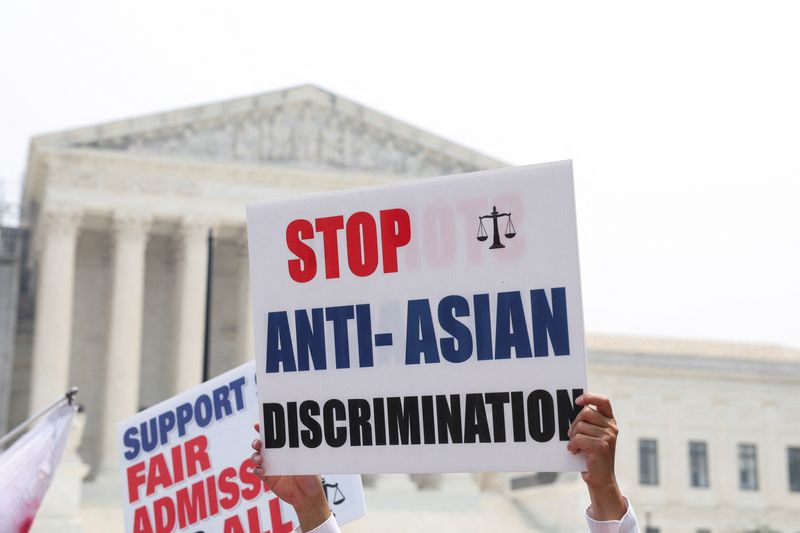By Joseph Ax, Daniel Wiessner and Tom Hals
(Reuters) - The Supreme Court's decision on Thursday barring race-conscious admissions policies will force universities to find new ways to attract a diverse student body – but experts said such efforts will likely open a new front in what has been a decades-long legal battle over race and college admissions.
The majority opinion, written by Chief Justice John Roberts and joined by the court's five other conservatives, held that giving some minority applicants a boost over others based on their race violated the U.S. Constitution.
But Roberts said admissions officers at colleges could consider "an applicant's discussion of how race affected his or her life, be it through discrimination, inspiration, or otherwise," as long as they do so on an individual basis.
"A benefit to a student who overcame racial discrimination, for example, must be tied to that student's courage and determination," he wrote. "In other words, the student must be treated based on his or her experiences as an individual — not on the basis of race."
That provision could make application essays, in which students often write about formative personal experiences, even more important as colleges strive for racial diversity. But the inherent nuance in taking race into account without allowing it to form the sole basis for an advantage creates a gray area that could lead to new lawsuits, experts said.
"The court made very clear that it will not tolerate workarounds or end-runs," said Dayna Bowen Matthew, the dean of George Washington University's law school. "What we can do, according to the court, is we can look at whether an applicant's race gave them 'courage and determination,' and that courage and determination is part of our university's goals."
But Brian Fitzpatrick, a law professor at Vanderbilt University who opposes affirmative action, said he expected some schools to "try to drive a truck through that little paragraph," leading to "years and years" of litigation.
Edward Blum, the founder of the group that brought Thursday's Supreme Court case, made it clear in a statement that he would be watching schools' reaction closely.
"The law will not tolerate direct proxies for racial classifications," Blum said. "We remain vigilant and intend to initiate litigation should universities defiantly flout this clear ruling."
The court's decision also did not explicitly bar schools from employing race-neutral programs to improve diversity.
In California, where voters banned affirmative action for public universities more than two decades ago, the state has spent more than $500 million on alternative approaches, including the use of socio-economic status, geographic location and targeted recruitment at schools with high numbers of minority students.
But such programs could draw legal challenges claiming that schools are simply using other criteria as a substitute for race.
In Virginia, for instance, a coalition of Asian American parents sued a high school that eliminated the use of standardized tests and guaranteed spots for top students at every area public middle school, a change that resulted in more Black and Latino students and fewer Asian American students.
A divided appeals court rejected the parents' claim, but many legal observers say the Supreme Court could choose to take up the case.
"Some of the same groups that have been challenging race-conscious decision-making have also begun to challenge race-neutral measures that are clearly designed to diversify," said Evan Caminker, a law professor at the University of Michigan. "There may be another shoe that some opponents of affirmative action would like to see dropped."
Some employment lawyers also warned that Thursday's decision, while focused on colleges, nevertheless could encourage more legal challenges to corporate diversity and inclusion programs.
Companies typically do not adopt the kinds of practices used by colleges that the court called out in its decision, such as assigning a "plus" to an applicant solely because of their race.

But in practice, corporate programs can sometimes give the appearance of granting preferences to particular groups, and the Supreme Court ruling could fuel opposition to them, said Krissy Katzenstein, a partner at Baker McKenzie in New York who represents employers.
"This is likely to generate additional challenges to (diversity) efforts, and there is language in the decision that will be seized on," she said.